ABSTRACT
Permafrost characterizes ground conditions in most of the Arctic and is increasingly thawing. While environmental consequences of permafrost thaw are under intense scrutiny by natural and life sciences, social sciences' studies on local communities' perceptions of change is thus far limited. This hinders the development of targeted adaptation and mitigation measures. We present the results of a survey on communities' perceptions of permafrost thaw, with a focus on subsistence activities, carried out between 2019 and 2020 in Aklavik (Northwest Territories, Canada), Longyearbyen (Svalbard, Norway), and Qeqertarsuaq (Qeqertalik Municipality, Greenland). Results show that the majority of the 237 participants are well aware of the consequences of permafrost thaw on the landscape as well as the connection between increased air temperature and permafrost thaw. The majority perceive permafrost thaw negatively although they do not perceive it as a challenge in all life domains. Permafrost thaw is perceived as a major cause for challenges in subsistence activities, infrastructure, and the physical environment. Different perceptions within the three study communities suggests that perceptions of thaw are not solely determined by physical changes but also influenced by factors related to the societal context, including discourses of climate change, cultural background, and land use.
Introduction
Rapid shifts in the environment caused by climate change impact lives in the Arctic, challenging food availability, safety and security (Brinkman et al., Citation2016; Watts et al., Citation2015), and deteriorating human health (Omazic et al., Citation2019; Sharma, Citation2010; Waits et al., Citation2018). Arctic air temperatures are rising up to three times as fast as the global average, and autumn and winter temperatures are expected to increase by a regional average of 4 °C by 2050 in the Northern Hemisphere (AMAP, Citation2019). This causes dramatic changes to all components of the cryosphere, including permafrost. Permafrost is ground that remains at or below 0°C for at least two consecutive years (Van Everdingen, Citation2005). The permafrost region covers about 24% of the land surface in the Northern Hemisphere (Gruber, Citation2012), including most of the Arctic (). Permafrost defines the physical structure of the ground and modulates resource availability to organisms, including people (Schuur & Mack, Citation2018). Permafrost is warming (Biskaborn et al., Citation2019) and thawing in many parts of the Arctic. Thawing of permafrost raises global attention due its contribution to the release of greenhouse gases, and constitutes an increasing concern for permafrost communities that are directly impacted. Watt-Cloutier emphasizes that permafrost thaw is perceived as a major issue among the many challenges Indigenous Peoples, and other residents of the North, are facing: ‘But perhaps the most shocking of all was that the very ground beneath our feet was no longer solid’ (Watt-Cloutier, Citation2018).
Figure 1. Location of the three focus communities located within the Arctic Circumpolar Permafrost Region.
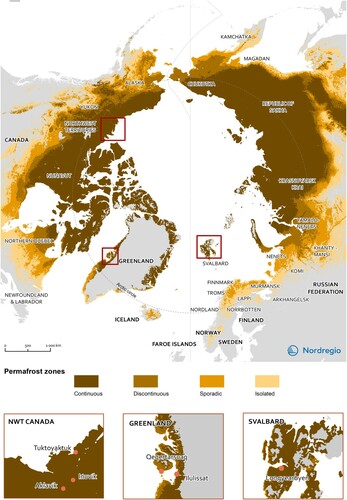
Permafrost thaw modifies frozen landscapes as the ground becomes softer, increasing the susceptibility to erosion, ground subsidence, and landslides. People living on permafrost are sensitive to ground conditions as thawing impacts ecosystems and infrastructure on which they depend to sustain their lives and maintain their cultural identities (Crate et al., Citation2017; Doloisio & Vanderlinden, Citation2020; Istomin & Habeck, Citation2016; Krause, Citation2021; Schuur & Mack, Citation2018). Challenges are expected to increase for the people living on permafrost as by 2050 permafrost will degrade and ultimately disappear in many areas of the Arctic, impacting the life of 3.3 million inhabitants (Ramage et al., Citation2021). Accelerating permafrost thaw thus poses an increased challenge to people's livelihoods if the pace of change is too rapid (Krause, Citation2021). Vulnerabilities in Arctic communities are the result of inherent ecosystem features, rates of change, and the abilities of social systems to quickly respond to changes (Alessa et al., Citation2008). In turn, the ability to respond to changes partly depends on differences between perceived and measured changes. Assessing risks related to climate change therefore requires both measuring the physical changes that occur as well as understanding the experiences and perceptions of these changes by the people impacted (Alessa et al., Citation2008; Rogan et al., Citation2005; Van Gevelt et al., Citation2019). Due largely to a lack of empirical studies, perceptions as drivers of behaviors and social changes are scarce in the context of environmental changes, especially in the context of permafrost thaw and impacts on livelihoods.
This study presents results of a pan-Arctic survey on people's perceptions and experiences of permafrost thaw, with a focus on subsistence activities. Subsistence activities are crucial in many Arctic permafrost communities and are being challenged by rapid environmental changes, compounding the impacts of social, economic, and political changes. Hunting, whaling, fishing, trapping, herding, and gathering of berries, mushrooms and other plants not only significantly contribute to local economies and wellbeing, but also shape social relationships and cultural identity of residents of the Arctic. Such subsistence activities are tied to intricate knowledge of local land-, ice- and waterscapes and to wellbeing, and provide food and other raw materials for everyday life. The focus on subsistence was motivated by their central contribution in living a good life in the Arctic (Holen & Gartler, Citation2020; Kruse et al., Citation2008; Watt-Cloutier, Citation2018) as well as the need from permafrost communities to better understand perceived impacts of climate change on these activities (Knapp & Trainor, Citation2015). As the first of its kind, the survey addresses local awareness of permafrost thaw, related perceived challenges, and perceived impacts on subsistence activities in three permafrost communities: Aklavik (Northwest Territories, Canada), Longyearbyen (Svalbard, Norway), and Qeqertarsuaq (Qeqertalik Municipality, Greenland). These constitute three distinct communities in terms of social, cultural, economic, and political context, yet they share a common feature: their location on permafrost. Comparing three different locales allows us to tease out different perceptions on permafrost thaw and provides an indication of how diverging perceptions are related to different societal contexts.
Material and methods
Study area
Aklavik, Longyearbyen, and Qeqertarsuaq are located on permafrost within discontinuous and continuous zones, where the probability of permafrost to occur is above 50% (Obu et al., Citation2019). Increasing occurrences of permafrost thaw have been reported in the three areas (Andrews et al., Citation2016; Burn & Kokelj, Citation2009; Hanssen-Bauer et al., Citation2019; Krause, Citation2021). The communities differ in their demography as well as socio-economic and cultural contexts.
Aklavik is a community situated along the Peel Chanel within the Mackenzie Delta, approximately 100 km south of the Beaufort Sea (). Aklavik is located in the bioclimate subzone E with a daily mean air temperature in of −26.3 °C in January and 13.9°C in July. The community has a population of 623 inhabitants (2018), most of whom are Inuvialuit or Gwich’in. Similar to most communities in the Canadian Arctic, Aklavik has a mixed subsistence-cash economy composed of wage employment and subsistence harvesting.
Longyearbyen is located on the western coast of the Svalbard Archipelago. The Nowegian town is in the bioclimate subzone A with daily mean air temperature of −14 °C in January and 6.5 °C in July. The surroundings are dominated by barren soils. With its 2368 inhabitants (2019), Longyearbyen is the largest settlement on Svalbard and its administrative center. Svalbard never had an indigenous population, and its settlements developed as coal mining towns. Longyearbyen is today a highly modern ‘urban village’ with an increasingly international population. As coal mining is being phased out, the main economic pillars are tourism and related industries, as well as research and higher education.
Qeqertarsuaq is a community located in central West Greenland in the south of Disko Island. The landscape surrounding the town is mountainous with steep coastlines. Qeqertarsuaq is in the bioclimate subzone D, with a daily mean air temperature of −22 °C in January and 7.9 °C in July. Qeqertarsuaq has a population of 839 inhabitants (2020), the majority of whom are Kalaallit (Greenlandic Inuit). The community has a mixed subsistence-cash economy composed of subsistence hunters and fishers as well as wage employment. The wage economy of Qeqertarsuaq is based on commercial fishing, seafood processing, public administration, tourism, and seasonal labor. People living in Qeqertarsuaq use the land, sea, and sea-ice for hunting and fishing.
Community survey and data collection
To analyze and compare perception of impacts related to permafrost thaw, we developed a community survey. The community survey consists of 42 questions (both open and closed, see Appendix A). Heterogeneous physical and social dynamics between communities pose a challenge to developing a common survey measuring perceptions, therefore the survey was adjusted with local research assistants and partners to accommodate local peculiarities.
The first section surveys the perceptions of impacts related to permafrost thaw. The second section inspects the role of subsistence activities in participants’ lives. The community survey was translated into three languages (English, Greenlandic, and Norwegian) and was carried out using a snowball sampling approach. In Aklavik and Qeqertarsuaq, local field assistants were hired to conduct the survey. The research assistants were acquainted with the field of research and guided a total of 237 participants through the survey (), representing 11% of the population above 18 years old in Aklavik, 15% in Qeqertarsuaq, and 4% in Longyearbyen. A relatively even distribution across gender and age groups was achieved. The answers were collected between February 2019 and October 2020.
Table 1. Number of respondents and their characteristics.
Results and discussion
Awareness of permafrost thaw
As indicates, participants associate permafrost thaw with climate change and relate it to local environmental impacts. Warmer, landslides, and soft are the three most recurrent words that participants associate with permafrost thaw in Aklavik. In Longyearbyen the most frequent words are infrastructure damages, warming, and landslides and in Qeqertarsuaq, climate change, pollution, and warmer. Two thirds of participants (n = 156) identify increasing temperatures as the main cause of thawing permafrost (Question 6). Others identify changes in snow thickness, not well-adapted infrastructure, and fires as further factors responsible for acceleration of permafrost thaw.
Figure 2. Word cloud illustrating the words associated by the respondents with permafrost thaw. Respondents answered question 1: Mention three words you associate with the thawing of frozen ground.
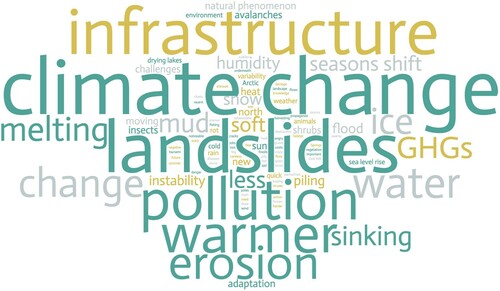
Study participants are well aware of the consequences of permafrost thaw on the landscape. The majority of participants in the three communities (71%, n = 168) perceive it as being an important or very important factor in explaining changes occurring in their physical environment (Question 5). Among all physical changes that participants observe, many are caused by permafrost thaw such as slumping of the ground, changes in hydrological conditions (drying or flooding of an area), and deepening of the active layer. This is more distinct in Aklavik, where most of the environmental changes observed are terrestrial changes associated with permafrost thaw (coastal erosion, slumping of the ground, and expansion of dried areas). In Longyearbyen and Qeqertarsuaq, most of the observed environmental changes are related to changes occurring at sea: sea ice conditions and storms. Participants also observe some changes associated to permafrost thaw such as an increase in the extent of wetlands, coastal erosion, and slumping ().
Figure 3. Observed environmental changes in the three permafrost communities. Respondents answered question 32: ‘Have you been affected by some of these physical changes when traveling in your surrounding environment?’
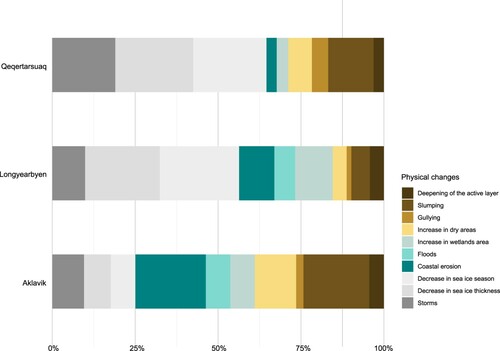
The majority of participants indicate that thawing of permafrost has led to negative changes over the past ten years (): 87% (n = 46) in Aklavik, 80% (n = 66) in Longyearbyen, and 65% (n = 65) in Qeqertarsuaq. There, 20% (n = 20) of the participants did not answer this question. While permafrost thaw is perceived as a negative change in all three study sites by three quarters (n = 177), the answers differ significantly across the study areas when asking participants whether permafrost thaw causes problems for them on an individual level (). While it is perceived as a problem for a majority in Aklavik, (74%, n = 39), it is less of a problem for participants in Longyearbyen (46%, n = 39), and in Qeqertarsuaq (21%, n = 21) ().
Figure 4. Perceived impact of permafrost thaw in the three permafrost communities. Respondents answered questions (A) 3 ‘Over the past 10 years, would you say that the thawing of the frozen ground has led to negative or positive changes?’ and (B) 4 ‘Do you think that thawing of the frozen ground causes problems to you?’
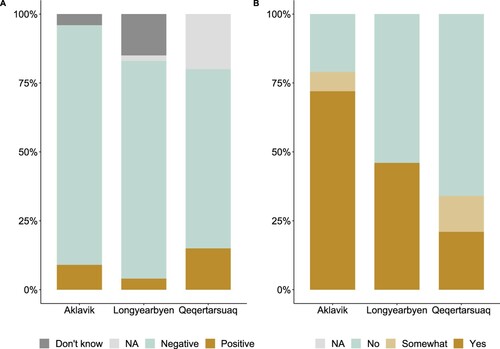
Participants’ awareness of permafrost thaw in their communities align well with current scientific knowledge reporting increased thaw in the three communities (Biskaborn et al., Citation2019; Daanen et al., Citation2011; Jaskólski et al., Citation2018; Kokelj et al., Citation2017) as well as with communities’ observations (Inuvialuit Regional Corporation, Citation2018). Differences in the awareness and perceptions relate to the variability of permafrost conditions in the three communities as well as their various landscape features. While permafrost thaw is observed in all three study sites, its impacts differ depending on environmental specificities. The high Arctic conditions and barren soils in Qeqertarsuaq and Longyearbyen hinder abrupt impacts of permafrost thaw. Aklavik, by contrast, lies within a lowland area with subarctic climatic conditions, environments that are more susceptible to thaw. Differences in participants’ observations of landscape changes also relate to the vicinity of the sea. Participants living directly at the coast in Qeqertarsuaq and Longyearbyen focus more on changes impacting sea and sea ice conditions compared to the ones living in Aklavik – located around 100 km south of the Beaufort Coast – for whom terrestrial changes have a greater impact.
Perceived impacts of permafrost thaw on subsistence activities
In the survey, subsistence is defined in a holistic way as any activity that serves material and immaterial human needs and is not primarily market-related (Gartler, Citation2018). However, the survey focuses specifically on hunting, fishing, and gathering practices, whether for provision or recreation. The food obtained through these activities is defined as country food.
In total, 60% (n = 142) of the participants engage in hunting and fishing and 57% (n = 135) gather berries, mushrooms, and medicinal plants. Most study participants in Aklavik and Qeqertarsuaq engage in hunting and fishing (74%, n = 39 and 64%, n = 64, respectively) and almost half of the participants (46%, n = 39) engage in these activities in Longyearbyen (questions 19 and 29, ). In Aklavik and Qeqertarsuaq, country food is essential in the daily diet: it is both valued and consumed regularly (questions 14 and 15, ). Country food represents half of the participants diet in Aklavik and 61% in Qeqertarsuaq. By contrast, country food is not essential in the diet of the participants in Longyearbyen, where it represents only 10% of their diet. These results suggest that while subsistence activities are perceived as essential for life in Aklavik and Qeqertarsuaq, it is mainly practiced as a recreational activity in Longyearbyen.
Figure 5. Respondent’s engagement in subsistence activities and reliance on country food in the three permafrost communities. Respondents answered questions 14 ‘Do you eat country food at least one time per week?’ – 15 ‘What percentage of your diet is country food?’ – 18 ‘How important is subsistence harvesting for your household?’ – 19 ‘Do you hunt or fish?’ – and 29 ‘Do you collect berries, mushrooms and/or medicinal plants/foods?’.
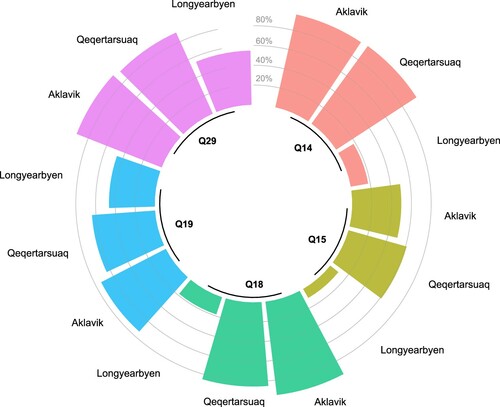
The survey also identifies differences in the type of species consumed throughout the year in the three communities (questions 24–27). Participants in Qeqertarsuaq mainly rely on marine resources throughout the year whereas terrestrial resources are the main source of country food in Aklavik. There, participants identify cervids (mainly caribou but also moose) and freshwater fishes as the main resources consumed throughout the year. In Qeqertarsuaq, the range of marine species consumed is diverse, with a predominance of sea fishes, whales, and seals. In Longyearbyen, antlers and sea fishes are the main resources caught when hunting and fishing.
Survey results show that permafrost thaw alters land-users’ harvesting practices (). Close to 85% (n = 45) of the participants from Aklavik consider that permafrost thaw affects their ability to obtain food from the land although 42% (n = 22) only feel somewhat affected. Almost half of the participants (47%, n = 47) are affected in Qeqertarsuaq, among whom a quarter (n = 25) feel somewhat affected. In Longyearbyen, permafrost thaw does not impact the study participants’ ability to obtain food from the land; and 68% (n = 57) do not perceive it as a threat for harvesting. Impacts of climate change on the ability for land-users to engage in subsistence activities have been reported for several other communities across the Arctic (Birchall & Bonnett, Citation2020; Brinkman et al., Citation2016; Gibson et al., Citation2018; Goldhar & Ford, Citation2010) where permafrost was listed among the most challenging impact (Inuvialuit Regional Corporation, Citation2018). These results show that the perceived impacts on the land-users’ activities depends on their engagement in subsistence activities as well as the type of species caught, being marine or terrestrial.
Perceived challenges related to permafrost thaw
While participants perceive permafrost thaw as having a negative impact on their lives in a whole, they do not perceive it as a challenge in all life domains (). Participants in Aklavik and Qeqertarsuaq perceive permafrost thaw as an important factor driving challenges related to their subsistence activities and to maintaining their culture. In Aklavik, 74% (n = 39) consider permafrost thaw as a very important factor for driving challenges that they encounter while engaging in subsistence activities. In contrast, participants in Longyearbyen consider permafrost thaw as an unimportant factor in driving challenges related to hunting and harvesting, and 36% (n = 30) indicate that they are unaware of such a connection. Similarly, permafrost thaw is not perceived as important in driving cultural challenges in Longyearbyen. These results highlight the strong links between subsistence activities and culture in indigenous communities where subsistence plays a pivotal role in people's cultural ways and livelihoods.
Figure 7. Communities’ perception of challenges related to permafrost thaw in six domains: subsistence activities, infrastructure, culture, health, natural environment, and economic activities. Respondents answered question 5 ‘How important is frozen ground thaw in explaining each of the following challenges?’. Results show the percentage of respondents who answered important and very important.
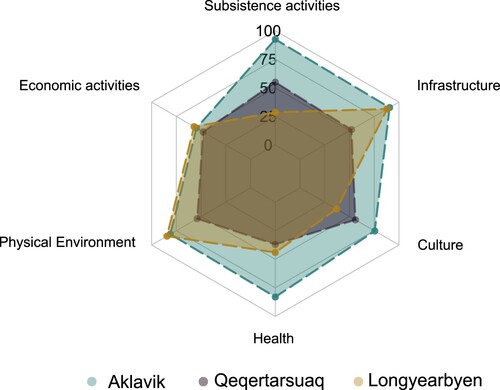
Results from question 5 reiterate that participants are well aware of the impacts of permafrost thaw on the physical environment. Permafrost thaw is considered in the three communities as important or very important in explaining challenges associated with the physical environment. However, 37% (n = 37) of study participants in Qeqertarsuaq indicate that they are uncertain in replying to this question (reply ‘do not know’). Challenges of permafrost thaw on health are perceived by 81% (n = 43) of the participants as important or very important in Aklavik (). Less than half of the participants in Qeqertarsuaq (37%, n = 37) and Longyearbyen (44%, n = 37) perceive permafrost thaw as a challenge to their health and a quarter of the participants in Longyearbyen (n = 21) and half (n = 51) in Qeqertarsuaq are unaware of challenges posed to human health by permafrost thaw. Focusing on the links between permafrost thaw, health, and well-being, Timlin et al. (Citation2021) show that permafrost thaw is not perceived as a direct risk for health in Qeqertarsuaq. Challenges to infrastructure are perceived as important or very important by 73% (n = 174) of all participants (). In Longyearbyen permafrost thaw is considered by a majority (69%, n = 58) as a very important factor for challenges posed to infrastructure. In all three study sites, permafrost thaw is considered important for explaining challenges related to economic activities although not crucial (). Economic activities, mainly seen as employment and financial issues, are not perceived as directly impacted by permafrost thaw. This relates to the type of employment in the three communities that are not directly affected by changes in permafrost conditions. A large number of participants in Qeqertarsuaq (between 36 and 51%) and in Longyearbyen (between 8 and 36%) replied ‘I don’t know’ for several of the questions about perceived challenges, suggesting that many are unsure and lack knowledge about the connections between society and permafrost change. These results show that while a majority of participants perceive permafrost thaw negatively, perceived impacts on everyday life activities vary greatly between individuals, both within and between the three communities. There are however trends; while permafrost thaw is perceived as an equal challenge for all domains of the participants’ lives in Aklavik and Qeqertarsuaq, participants in Longyearbyen identify challenges related to the physical environment and infrastructure as more important. Social perceptions of permafrost thaw are not solely determined by physical impacts and experiences, but also by immaterial factors such as culture and land use. The interconnection between physical, material, and immaterial impacts has been reported for several other Arctic regional contexts in numerous studies (Andrachuk, Citation2008; Crate, Citation2014; Crate et al., Citation2017; Doloisio & Vanderlinden, Citation2020; Karjalainen & Habeck, Citation2004; Timlin et al., Citation2021). Environmental perception is linked to a large number of factors, including past experiences and current value orientations (Zube, Citation1999). Perceptions also rely on some measure of change that are linked to the time one lived in a specific environment, as well as to the transmission of information from others and the type of their experience (Alessa et al., Citation2008; Davidson-Hunt & Berkes, Citation2003; Ford et al., Citation2006).
Conclusion
This article presents the results of community surveys on perceptions of permafrost thaw on the life of permafrost inhabitants. The results indicate that participants are well aware of the consequences of permafrost thaw on their surrounding landscapes. Differences in observed physical changes emerge due to various permafrost conditions and environmental changes in the surroundings of the three communities. Participants perceive permafrost thaw negatively and indicate that changes have impacted their lives in the past ten years. In Aklavik and Qeqertarsuaq, where subsistence activities are important, permafrost thaw affects the participants’ ability to engage in these activities. Participants’ perceptions of specific challenges within different life domains are diffuse and diverse. While participants in Aklavik and Qeqertarsuaq perceive permafrost thaw as a challenge in all life domains, participants in Longyearbyen identify specific challenges in the domains of infrastructure and environmental changes. Social perceptions of permafrost thaw are not solely determined by physical impacts, but also by immaterial factors such as culture and land use. The survey adds new perceptions of the impact of permafrost thaw, which are critical to understand adaptation needs as the capacity to answer to changes depends both on the available knowledge as well as the perceptions toward these changes. Effective adaptation measures will be well received if communities perceive and understand the changes occurring in their surroundings. In communities where subtle changes is ongoing, communities will take longer to react. There, it might be crucial for researcher to focus on modeling and presenting projections of change to accelerate the design of adaptation measures. Considering the differences in social and political structures as well as cultural behaviors is also key to design and prioritize adaptation measures to permafrost thaw at the community level. As permafrost is or becomes inevitably no longer solid in many communities, adaptation will stand on solid ground when perceptions will be accounted. Further research could aim at disentangling the specific factors influencing perceptions of permafrost thaw within and between different permafrost communities in order to pinpoint specific domains of adaptation strategies.
Supplemental Material
Download MS Excel (21.1 KB)Acknowledgements
This study was conducted under the Northwest Territories Scientific Research License No. 16531. Ethical approval was obtained through the Aurora College Research Ethics Committee (Protocol Nr. 20190101). We would like to thank our research assistants Kirsten Pedersen, Jessi Pascal, and Millie Greenland for their help in carrying out the surveys.
Disclosure statement
No potential conflict of interest was reported by the author(s).
Additional information
Funding
References
- Alessa, L., Kliskey, A., Williams, P., & Barton, M. (2008). Perception of change in freshwater in remote resource-dependent Arctic communities. Global Environmental Change, 18(1), 153–164. https://doi.org/10.1016/j.gloenvcha.2007.05.007
- AMAP. (2019). An update to key findings of snow, water, ice and permafrost in the Arctic (SWIPA) 2017. AMAP. 12.
- Andrachuk, M. (2008). An assessment of the vulnerability of Tuktoyaktuk to environmental and socio-economic changes [unpublished master’s thesis]. University of Guelph.
- Andrews T. D., Kokelj, S. V., MacKay, G., Buysse, J., Kritsch, I., Andre, A., & Lantz, T. (2016). Permafrost thaw and aboriginal cultural landscapes in the Gwich’in Region, Canada. APT Bulletin: The Journal of Preservation Technology, 47(1), 15–22.
- Birchall, F. S., & Bonnett, N. (2020, March 14). Thinning sea ice and thawing permafrost: Climate change adaptation planning in Nome, Alaska. Environmental Hazards, 19(2), 152–170. https://doi.org/10.1080/17477891.2019.1637331
- Biskaborn, B. K., Smith, S. L., Noetzli, J., Matthes, H., Vieira, G., Streletskiy, D. A., Schoeneich, P., Romanovsky, V. E., Lewkowicz, A. G., Abramov, A., & Allard, M. (2019, January 16). Permafrost is warming at a global scale. Nature Communications, 10(1), 1–1. https://doi.org/10.1038/s41467-018-08240-4
- Brinkman, T. J., Hansen, W. D., Chapin, F. S., Kofinas, G., BurnSilver, S., & Rupp, T. S. (2016, December). Arctic communities perceive climate impacts on access as a critical challenge to availability of subsistence resources. Climatic Change, 139(3), 413–427. https://doi.org/10.1007/s10584-016-1819-6
- Burn, C. R., & Kokelj, S. V. (2009). The environment and permafrost of the Mackenzie Delta Area. Permafrost and Periglacial Processes, 20(2), 83–105. https://doi.org/10.1002/ppp.655
- Crate, S. A. (2014). An ethnography of change in Northeastern Siberia. Sibirica: The Journal of Siberian Studies, 13(1), 40–74. https://doi.org/10.3167/sib.2014.130102
- Crate, S. A., Ulrich, M., Habeck, J. O., Desyatkin, A. R., Desyatkin, R. V., Fedorov, A. N., Hiyama, T., Iijima, Y., Ksenofontov, S., Mészáros, C., & Takakura, H. (2017). Permafrost livelihoods: A transdisciplinary review and analysis of thermokarst-based systems of indigenous land use. Anthropocene, 18, 89–104. https://doi.org/10.1016/j.ancene.2017.06.001
- Daanen, R. P., Ingeman-Nielsen, T., Marchenko, S. S., Romanovsky, V. E., Foged, N., Stendel, M., Christensen, J. H., & Hornbech Svendsen, K. (2011, November 24). Permafrost degradation risk zone assessment using simulation models. The Cryosphere, 5(4), 1043–1056. https://doi.org/10.5194/tc-5-1043-2011
- Davidson-Hunt, I., & Berkes, F. (2003). Learning as you journey: Anishinaabe perception of social-ecological environments and adaptive learning. Conservation Ecology, 8(1).
- Doloisio, N., & Vanderlinden, J. P. (2020). The perception of permafrost thaw in the Sakha Republic (Russia): narratives, culture and risk in the face of climate change. Polar Science, 26, 100589. https://doi.org/10.1177/02632764211030996
- Ford, J. D., Smit, B., & Wandel, J. (2006). Vulnerability to climate change in the Arctic: A case study from Arctic Bay, Canada. Global Environmental Change, 16(2), 145–160. https://doi.org/10.1016/j.gloenvcha.2005.11.007
- Gartler, S. (2018). One word, many worlds: The multivocality of “subsistence”. Alaska Journal of Anthropology, 16(2), 49–63.
- Gibson, C. M., et al. (2018). Wildfire as a major driver of recent permafrost thaw in boreal peatlands. Nature Communications, 9(1), 3041. https://doi.org/10.1038/s41467-018-05457-1
- Goldhar, C., & Ford, J. D. (2010). Climate change vulnerability and food security in Qeqertarsuaq, Greenland. In Community adaptation and vulnerability in Arctic regions (pp. 263–283). Springer.
- Gruber, S. (2012, February 17). Derivation and analysis of a high-resolution estimate of global permafrost zonation. The Cryosphere, 6(1), 221–233. https://doi.org/10.5194/tc-6-221-2012
- Hanssen-Bauer, I., Førland, E. J., Hisdal, H., Mayer, S., Sandø, A. B., & Sorteberg, A. (2019). 2019 Climate in Svalbard 2100. A knowledge base for climate adaptation.
- Holen, D., & Gartler, S. (2020). ECONOR. Chapter 6. Interdependency of subsistence and market economies in the Arctic Introduction: A Way of Life in the North.
- Inuvialuit Regional Corporation. (2018). Inuvialuit on the frontline of climate change: development of a regional climate change adaptation strategy Report https://irc.inuvialuit.com/document/inuvialuit-frontline-climate-change.
- Istomin, K. V., & Habeck, J. O. (2016). Permafrost and indigenous land use in the northern Urals: Komi and Nenets reindeer husbandry. Polar Science, 10(3), 278–287. https://doi.org/10.1016/j.polar.2016.07.002
- Jaskólski, M. W., Pawłowski, Ł, & Strzelecki, M. C. (2018). High Arctic coasts at risk—the case study of coastal zone development and degradation associated with climate changes and multidirectional human impacts in Longyearbyen (Adventfjorden, Svalbard). Land Degradation and Development, 29(8), 2514–2524. https://doi.org/10.1002/ldr.2974
- Karjalainen, T. P., & Habeck, J. O. (2004). When ‘the environment’ comes to visit: Local environmental knowledge in the Far North of Russia. Environmental Values, 13(2), 167–186. https://doi.org/10.3197/0963271041159877
- Knapp, C. N., & Trainor, S. F. (2015). Alaskan stakeholder-defined research needs in the context of climate change. Polar Geography, 38(1), 42–69. https://doi.org/10.1080/1088937X.2014.999844
- Kokelj, S. V., Lantz, T. C., Tunnicliffe, J., Segal, R., & Lacelle, D. (2017, April 1). Climate-driven thaw of permafrost preserved glacial landscapes, northwestern Canada. Geology, 45(4), 371–374. https://doi.org/10.1130/G38626.1
- Krause, F. (2021). The tempo of solid fluids: On river ice, permafrost, and other melting matter in the Mackenzie Delta. Theory, Culture & Society, 39(2), 31–52. https://doi.org/10.1177/02632764211030996
- Kruse, J., Poppel, B., Abryutina, L., Duhaime, G., Martin, S., Poppel, M., Kruse, M., Ward, E., Cochran, V., & Hanna, V. (2008). Survey of living conditions in the Arctic (SLiCA). In Barometers of quality of life around the globe (pp. 107–134). Springer.
- Obu, J., Westermann, S., Bartsch, A., Berdnikov, N., Christiansen, H. H., Dashtseren, A., Delaloye, R., Elberling, B., Etzelmüller, B., Kholodov, A., & Khomutov, A. (2019, June 1). Northern Hemisphere permafrost map based on TTOP modelling for 2000–2016 at 1 km2 scale. Earth-Science Reviews, 193, 299–316. https://doi.org/10.1016/j.earscirev.2019.04.023
- Omazic, A., Bylund, H., Boqvist, S., Högberg, A., Björkman, C., Tryland, M., Evengård, B., Koch, A., Berggren, C., Malogolovkin, A., & Kolbasov, D. (2019, December). Identifying climate-sensitive infectious diseases in animals and humans in Northern regions. Acta Veterinaria Scandinavica, 61(1), 1–2. https://doi.org/10.1186/s13028-019-0490-0
- Ramage, J., Jungsberg, L., Wang, S., Westermann, S., Lantuit, H., & Heleniak, T. (2021, January 6). Population living on permafrost in the Arctic. Population and Environment, 43(1), 22–38. https://doi.org/10.1007/s11111-020-00370-6.
- Rogan, R., O’Connor, M., & Horwitz, P. (2005). Nowhere to hide: Awareness and perceptions of environmental change, and their influence on relationships with place. Journal of Environmental Psychology, 25(2), 147–158. https://doi.org/10.1016/j.jenvp.2005.03.001
- Schuur, E. A., & Mack, M. C. (2018). Ecological response to permafrost thaw and consequences for local and global ecosystem services. Annual Review of Ecology, Evolution, and Systematics, 49(1), 279–301. https://doi.org/10.1146/annurev-ecolsys-121415-032349
- Sharma, S. (2010, October). Assessing diet and lifestyle in the Canadian Arctic Inuit and Inuvialuit to inform a nutrition and physical activity intervention programme. Journal of Human Nutrition and Dietetics, 23, 5–17. https://doi.org/10.1111/j.1365-277X.2010.01093.x
- Timlin, U., Kauppila, S., Jungsberg, L., Nordström, T., Schmidt-Pedersen, K., Kyngäs, H., & Rautio, A. (2021, June). Perception of health challenges. Self-rated health and feeling of empowerment in a changing climate and environment with permafrost thawing. Sci, 3(2), 28. https://doi.org/10.3390/sci3020028
- Van Everdingen, R. (2005). Multi-language glossary of permafrost and related ground-ice terms. National Snow and Ice Data Center/World Data Center for Glaciology, Boulder, CO. World Wide Web Address: http://nsidc.org/fgdc/glossary.
- Van Gevelt, T., Abok, H., Bennett, M. M., Fam, S. D., George, F., Kulathuramaiyer, N., Low, C. T., & Zaman, T. (2019). Indigenous perceptions of climate anomalies in Malaysian Borneo. Global Environmental Change, 58, 101974. https://doi.org/10.1016/j.gloenvcha.2019.101974
- Waits, A., Emelyanova, A., Oksanen, A., Abass, K., & Rautio, A. (2018, December 1). Human infectious diseases and the changing climate in the Arctic. Environment International, 121, 703–713. https://doi.org/10.1016/j.envint.2018.09.042
- Watt-Cloutier, S. (2018, May 1). The right to be cold: One woman's fight to protect the Arctic and save the planet from climate change. U of Minnesota Press. 191.
- Watts, N., Adger, W. N., Agnolucci, P., Blackstock, J., Byass, P., Cai, W., Chaytor, S., Colbourn, T., Collins, M., Cooper, A., & Cox, P. M. (2015, November 7). Health and climate change: Policy responses to protect public health. The Lancet, 386(10006), 1861–1914. https://doi.org/10.1016/S0140-6736(15)60854-6
- Zube, E. H. (1999). Environmental perception. In Environmental geology (pp. 214–246). Springer.

